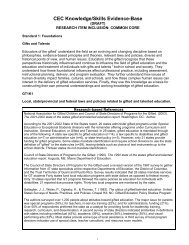with Flexible Grouping and Compacting - NAGC
with Flexible Grouping and Compacting - NAGC
with Flexible Grouping and Compacting - NAGC
Create successful ePaper yourself
Turn your PDF publications into a flip-book with our unique Google optimized e-Paper software.
Make Differentiation “do-able”<strong>with</strong> <strong>Flexible</strong><strong>Grouping</strong> <strong>and</strong> <strong>Compacting</strong>Ann RobinsonCenter for Gifted EducationUniversity of Arkansas at Little RockNational Association for Gifted Children &Maryl<strong>and</strong> Association for EducationRegional AcademyColumbia, Maryl<strong>and</strong>January 24, 2009
<strong>Grouping</strong> Gossip What have you heard? Using the Heads Together technique,exchange two examples of groupinginformation <strong>with</strong> respect to high abilitylearners.
What are common models offlexible grouping? Within-class reading <strong>and</strong> math groups Cross-grade grouping or the Joplin Plan Cluster <strong>Grouping</strong> Pull-out <strong>Grouping</strong>
With-in Class <strong>Grouping</strong> How to Group– Divide students into smaller groups according toprior performance.– Students work directly <strong>and</strong> proportionally <strong>with</strong> theteacher each day.– Individual students or groups work by themselveswhen not <strong>with</strong> the teacher.– More common at the elementary/middle levels.
With-in Class <strong>Grouping</strong> Research Evidence– Gains in Mathematics– Gains in overall for high, medium, <strong>and</strong> lowachievingstudents
Cross-grade <strong>Grouping</strong>(Joplin Plan) How to Group– Students are regrouped across grade levelsbased on performance.– May have as many as 9 groups for 3 to 5grade levels.– In reading, instruction occurs in multi-agegroups for 90 minutes.– Students return to classroom for 30 minutesof free reading.– -More common at upper elementary/middlelevels.
Cross-grade <strong>Grouping</strong>(Joplin Plan) Research Evidence– Gains overall frequently reported.– In one study, cluster grouping in math <strong>with</strong>differentiated curriculum produced highergains.
Cluster <strong>Grouping</strong> How to Group– A cluster of 3 - 10 gifted students areplaced for the year <strong>with</strong> a teacher trained indifferentiation for high ability learners. Research Evidence– Gains overall reported.– More students reported as high achieving.
Pull-out Programs How to Group– High ability learners are removed from theclassroom to work <strong>with</strong> a specialist teacher.– Usually enrichment-based.– Meet from 1 hour per week to 1 - 2 days perweek. Research Evidence– Gains in achievement, critical thinking <strong>and</strong>creative thinking.– Gains reported for programs articulated <strong>with</strong>subject matter curriculum.
Spot the <strong>Grouping</strong> Pattern . . . Susanna’s Case Antonio’s Casefrom Rogers, 2006
Curriculum <strong>Compacting</strong>Who needs it?How is it done?
Definition of <strong>Compacting</strong>•Identifying learning objectives,pretesting students for mastery <strong>and</strong>eliminating needless teaching or practice.The time saved may be used to provideacceleration or enrichment. The teacherassesses skills or knowledge prior toinstruction <strong>and</strong> uses this information tomodify the curriculum.
Student Behaviors which suggestcompacting: Focus on students who•Consistently finish tasks quickly•Make careless mistakes•Create own distractions•Bring outside reading materials•Test well despite average or below class work•Consistently perform high in an academic area•Ask questions that suggest advanced familiarity <strong>with</strong> thematerial•Express interest in pursuing alternate or advanced topics-Starko
Steps To <strong>Compacting</strong>1. Identify objectives in subject area/grade level2. Find or develop a means of pretesting3. Identify students who have met them4. Pretest5. Eliminate practice, drill or instruction6. Streamline instruction7. Provide individualized, enriched or acceleratedinstruction8. Maintain records <strong>and</strong> documentation
Strategies For <strong>Compacting</strong>•Compactor•Most Difficult First•Day 3 Pretest Option
The CompactorTHE COMPACTORJoseph Renzulli & Linda H. SmithStudent Name ____________________________________________Area of Strength Documenting Mastery Alternate Activities- as adapted by Winebrenner
The “Most Difficult First” ProcedureTeacher teaches lesson; gives homework assignment, allows15-20 minutes for students to start in class.Makes offer to all students:Anyone who can complete the exercises I have labeled “5 mostdifficult” before the class ends, NEATLY, LEGIBLY, AND TO____ ACCURACY is finished practicing.Teacher helps only those students who begin at the beginning.-Winebrenner
The “Most Difficult First” Procedure (cont’d)Student who thinks s/he has completed most difficult correctlycomes to teacher.When teacher finds the first paper to meet criteria, its ownerbecomes the CHECKER for others who want to qualify.Those who qualify may do any other work in the “time they buy”as long as they:•BOTHER NO ONE•CALL NO ATTENTION TO THEMSELVES(most useful to mathematics, grammar, geography….)-Winebrenner
The “Day Three Pretest Option”Procedure•Teacher announces on Day One of new unit that anystudent who feels they “know” this area may try to“test out.” Substitute enrichments are described <strong>and</strong>criterion levels for test performance are clarified.•For the first two days, the teacher provides anOVERVIEW of the entire unit at an accelerated paceof presentation.
The “Day Three Pretest Option”Procedure (cont’d)On Day Three the criterion-referencedtest/task is administered to all interestedstudents. Teacher begins regular courseof instruction on unit for those who decidenot to “test out.”
The “Day Three Pretest Option”Procedure (cont’d)•By Day Four those who have “tested out” beginworking on long-term enrichment projectsconnected to the unit of study that extend ormore fully develop the objectives of the unit.They are expected to work independently,meeting <strong>with</strong> the teacher outside of class timewhen they have questions or concerns. If theycannot work effectively as independent learners,they will return to the teacher-directed learningexperiences.-Winebrenner
The “Day Three Pretest Option”Procedure (cont’d)•The “tested out” students’ grades are based onthe averaging of their pretest performance <strong>and</strong>the evaluations of their enrichment project.(May be most useful in spelling, grammar, vocabulary,mathematics, map skills, or science/language arts/socialscience units that have been taught in earlier grades,…?)-Winebrenner
The <strong>Compacting</strong>Challenge•Alternative Activities•Enrichment Projects
Alternative Activities•Where can you find them?•How can you manage them?•When do you use them?•Are they engaging?
If you want to know more….•Gentry, M. & Mann, R.L. (2008). Total School Cluster <strong>Grouping</strong><strong>and</strong> Differentiation (<strong>with</strong> CD-ROM). Creative Learning Press.•Reis, S.M. & Renzulli, J.S. (2005). Curriculum <strong>Compacting</strong>: AnEasy Start to Differentiating for High-Potential Students.Prufrock Press.•Starko, A. J. (1986). It’s About Time. Creative Learning Press.•Winebrenner, S. (2001) Teaching Gifted Kids in the RegularClassroom. Updated edition. Free Spirit Press.•Winebrenner, S. & Brulles, D. (2009) The Cluster <strong>Grouping</strong>H<strong>and</strong>book (<strong>with</strong> CD-ROM). Free Spirit Press.
Ann RobinsonCenter for Gifted EducationUniversity of Arkansas at Little Rock2801 South University AvenueLittle Rock, AR 72204-1099http://giftedctr.ualr.edu
















